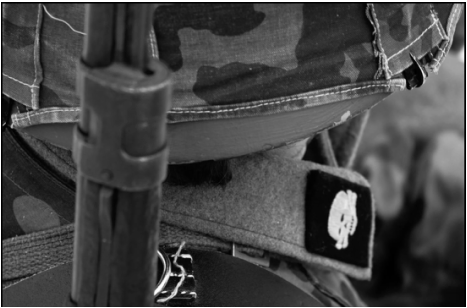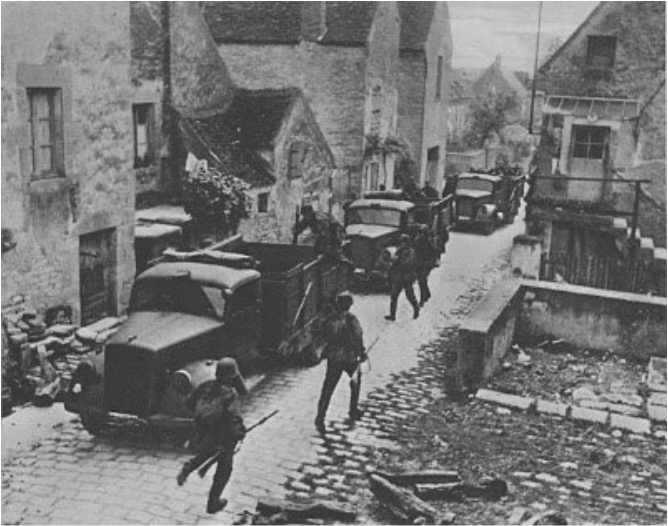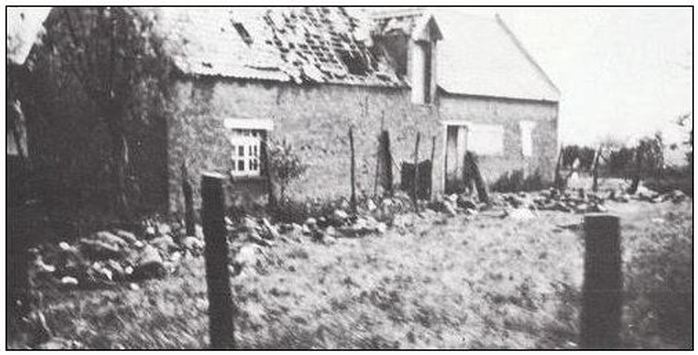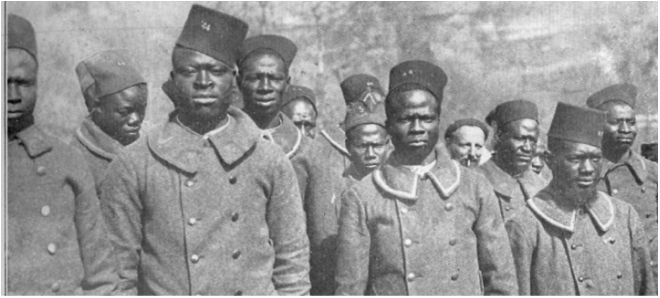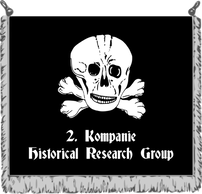War Crimes of the SS-Totenkopfdivision
Introduction:
When the SS-Totenkopfdivision rolled into France in the summer of 1940, it would find itself in combat for the first time. The Division was inexperienced and trained by unqualified officers and personnel, and was unprepared for the combat they would find themselves in during the campaign. The list of their atrocities committed is a testament to their inability to cope with the stresses of combat, as the dates of war crimes committed seem to coincide with dates the units were in heavy combat and/or taking very high casualties. The members of the unit who had participated in the Invasion of Poland, before the formation of the Division, had already been brutalized in behind the lines atrocities, and these were the men looked to as leaders by the younger more impressionable recruits to the unit.
The men experienced watching their friends and leaders killed and maimed for the first time. The British were known to be using “dum-dum” or exploding rounds, which were banned by the Geneva Convention, and caused a lot of mental stress to the men of the SS-TK-Division who had to witness the end result of these rounds. They were also pre-conditioned to follow orders without question, and to look upon those of African descent to be of an inferior race, which can be apparent in the massacre of Senegalese troops by the men of the SS-TK. Although there were various things, such as the British using white flags and still opening fire, the “dum-dum” rounds, finding German soldiers mutilated, that the men of the SS-Totenkopfdivision experienced in their drive through France, these wouldn’t necessarily cause the same effect on a combat-conditioned unit, as they did on the men of this formation.
It all comes down to the fact that the men of the SS-Totenkopfdivision were not mentally prepared for the stresses of combat, and therefore left a path of destruction in their wake any time they suffered a major setback, loss, or substantial casualties, beginning with their losses during the Battle of Arras on May 21.
Following the campaign in France, the Division would be refitted with new personnel, and the atrocities that seemed to follow the Division through France didn’t plague it throughout the rest of the war, where it served with distinction on the Eastern Front. One must also note, not every man of the SS-Totenkopfdivision is guilty of committing atrocities during the campaign in France. All the instances of war crimes are carried out by small individual units, and therefore one cannot blame the entire formation, but the individuals present at the time, and guilty of the crime. Below you will find a list, and a basic summary of the crimes committed by the SS-Totenkopfdivision during WWII. All were committed over a span of a few weeks during May-June 1940.
With the exception of the Le Paradis Massacre, all of these war crimes are not well known, and facts and information regarding their circumstances is difficult to attain today as most survivors or witnesses are deceased. Also the fact that the Germans didn’t document these atrocities, and any documentation made at the time was likely destroyed by the Germans during the war, it makes finding information and research material and contacts very difficult. Some of these events feature very limited information, but it is all the information that is known at this time.
One must also note that war in itself is a crime. To take the life of another human being is a crime in every civilization. Yet, we take young men and indoctrinate them, turn them into killers and expect them to be able to make moral distinctions on life and death when they have a completely different concept of life and death, living on the front line. No person can judge the actions of a man in combat unless they were there. It is impossible to know all the stressors and factors that lead to normally good and moral men committing atrocities. In every war before and since WWII, we have seen war crimes. In WWII we saw it on both sides. Young Americans after the stress of combat were just as apt to make a decision to kill a prisoner as a young German or British soldier might be, which is evident in the multiple cases of war crimes that were committed by all sides during the war. The purpose of this article is not to condone, underwrite, or justify any of the following actions, but simply to make an easily accessible historical record of events that are not well known.
When the SS-Totenkopfdivision rolled into France in the summer of 1940, it would find itself in combat for the first time. The Division was inexperienced and trained by unqualified officers and personnel, and was unprepared for the combat they would find themselves in during the campaign. The list of their atrocities committed is a testament to their inability to cope with the stresses of combat, as the dates of war crimes committed seem to coincide with dates the units were in heavy combat and/or taking very high casualties. The members of the unit who had participated in the Invasion of Poland, before the formation of the Division, had already been brutalized in behind the lines atrocities, and these were the men looked to as leaders by the younger more impressionable recruits to the unit.
The men experienced watching their friends and leaders killed and maimed for the first time. The British were known to be using “dum-dum” or exploding rounds, which were banned by the Geneva Convention, and caused a lot of mental stress to the men of the SS-TK-Division who had to witness the end result of these rounds. They were also pre-conditioned to follow orders without question, and to look upon those of African descent to be of an inferior race, which can be apparent in the massacre of Senegalese troops by the men of the SS-TK. Although there were various things, such as the British using white flags and still opening fire, the “dum-dum” rounds, finding German soldiers mutilated, that the men of the SS-Totenkopfdivision experienced in their drive through France, these wouldn’t necessarily cause the same effect on a combat-conditioned unit, as they did on the men of this formation.
It all comes down to the fact that the men of the SS-Totenkopfdivision were not mentally prepared for the stresses of combat, and therefore left a path of destruction in their wake any time they suffered a major setback, loss, or substantial casualties, beginning with their losses during the Battle of Arras on May 21.
Following the campaign in France, the Division would be refitted with new personnel, and the atrocities that seemed to follow the Division through France didn’t plague it throughout the rest of the war, where it served with distinction on the Eastern Front. One must also note, not every man of the SS-Totenkopfdivision is guilty of committing atrocities during the campaign in France. All the instances of war crimes are carried out by small individual units, and therefore one cannot blame the entire formation, but the individuals present at the time, and guilty of the crime. Below you will find a list, and a basic summary of the crimes committed by the SS-Totenkopfdivision during WWII. All were committed over a span of a few weeks during May-June 1940.
With the exception of the Le Paradis Massacre, all of these war crimes are not well known, and facts and information regarding their circumstances is difficult to attain today as most survivors or witnesses are deceased. Also the fact that the Germans didn’t document these atrocities, and any documentation made at the time was likely destroyed by the Germans during the war, it makes finding information and research material and contacts very difficult. Some of these events feature very limited information, but it is all the information that is known at this time.
One must also note that war in itself is a crime. To take the life of another human being is a crime in every civilization. Yet, we take young men and indoctrinate them, turn them into killers and expect them to be able to make moral distinctions on life and death when they have a completely different concept of life and death, living on the front line. No person can judge the actions of a man in combat unless they were there. It is impossible to know all the stressors and factors that lead to normally good and moral men committing atrocities. In every war before and since WWII, we have seen war crimes. In WWII we saw it on both sides. Young Americans after the stress of combat were just as apt to make a decision to kill a prisoner as a young German or British soldier might be, which is evident in the multiple cases of war crimes that were committed by all sides during the war. The purpose of this article is not to condone, underwrite, or justify any of the following actions, but simply to make an easily accessible historical record of events that are not well known.
I. 22. Mai. 1940 - Aubigny-en-Artois
- On 22. Mai, 1940, members of I./SS-TK-I.R.1, commanded by Hellmuth Becker murdered 92 French civilians in the village of Aubigny-en-Artois. As a possible pre-cursor to this event, or the events at Vandelicourt on this same day; three downed German pilots had been found to have been stoned to death in the village of Vimy on 19. Mai, 1940. On 21. Mai, I./SS-TK-I.R.1 was engaged in trying to cross the Scarpe River in the town of Aubigny-en-Artois, and was receiving heavy fire and stiff resistance and took casualties. During the night of 21-22. Mai, the British troops fled the village and the next morning, I.SS-TK-I.R.1 moved in and secured the village.
Upon arrival, they found the uniforms and small clothes of British soldiers strewn about the area, and assumed they had hid amongst the villagers in civilian clothes. The SS-TK troops then went house to house and removed all the individuals to search for the British soldiers. An older man came out brandishing a shotgun and he was shot on site. Subsequently, approximately 70 males were then taken to a nearby quarry and shot by machine-guns.
When trying to understand the possible cause for the events in Aubigny-en-Artois, there are several factors to consider. The first thing to consider is that many of the men who made up this unit came from SS-Totenkopfstandarte 1. “Oberbayern” which was formed and stationed at Dachau, and many had been brutalized in the camp system, and brought this nature with them to the campaign in France. The second fact being; this unit was fairly inexperienced in combat and had taken casualties and thus was suffering mentally from the stress of losing friends. The news of hearing about the downed pilots being stoned could have also led to tenacity of the SS men when they entered the village. Ultimately, the British uniforms, and the older man brandishing the shotgun is what finally caused the situation to boil over. Feeling like they were being deceived, an inexperienced commander, who probably had prior service with the SS-Totenkopfverbande in the camp system, made the decision to execute all the males since they couldn’t determine who was French and who was British.
II. 22. Mai. 1940 - Vandelicourt / Berles-Montchel
- On 22. Mai, 1940 members of SS-TK-I.R.2 murdered 45 civilians in the hamlet of Vandelicourt and the village of Berles-Montchel. On the same day men of SS-TK-I.R.1 were killing civilians in the village of Augigny-en-Artois, the men of SS-TK-I.R.2 were terrorizing the villages of Vandelicourt and Berles-Montchel.
According to an eye-witness, the SS men drove into town and jumped down out of their trucks and began shooting at anything that looked suspicious and began asking the villagers if there were any British soldiers in the area.
At some point, soldiers from this unit began smashing basement windows and throwing in hand grenades, killing those inside, as well as bringing villagers out of their homes and shooting them in the streets. Several villagers were actually murdered inside their own homes.
Eventually, the officer commanding this small unit arrived, and upon speaking with a lady from the village whose son had been executed, he halted all the killing, ordered the men back in their trucks and on their way back to join the rest of their unit.
This atrocity is the most odd in the fact that the men entering the village did not encounter any resistance, nor lose any personnel in the action. One must surmise the hatred came from the news of the three stoned German pilots mentioned above. Another possibility for animosity could be due to the large numbers the Division lost the day before during The Battle of Arras. One can also note that both this instance and the instance in Augigny-en-Artois happened relatively close to one another, and it is possible other rumors were spreading through the ranks. One rumor that circulated, and is still discussed today is the possible murder of 200 SS prisoners who were made to strip naked and then left in an open pit. Although German veterans claim this happened, no SS units in the area show that many missing personnel or casualties during the dates of the rumored massacre. None the less, it could have been believed and fueled the fire for the men of SS-Totenkopf.
- On 22. Mai, 1940, members of I./SS-TK-I.R.1, commanded by Hellmuth Becker murdered 92 French civilians in the village of Aubigny-en-Artois. As a possible pre-cursor to this event, or the events at Vandelicourt on this same day; three downed German pilots had been found to have been stoned to death in the village of Vimy on 19. Mai, 1940. On 21. Mai, I./SS-TK-I.R.1 was engaged in trying to cross the Scarpe River in the town of Aubigny-en-Artois, and was receiving heavy fire and stiff resistance and took casualties. During the night of 21-22. Mai, the British troops fled the village and the next morning, I.SS-TK-I.R.1 moved in and secured the village.
Upon arrival, they found the uniforms and small clothes of British soldiers strewn about the area, and assumed they had hid amongst the villagers in civilian clothes. The SS-TK troops then went house to house and removed all the individuals to search for the British soldiers. An older man came out brandishing a shotgun and he was shot on site. Subsequently, approximately 70 males were then taken to a nearby quarry and shot by machine-guns.
When trying to understand the possible cause for the events in Aubigny-en-Artois, there are several factors to consider. The first thing to consider is that many of the men who made up this unit came from SS-Totenkopfstandarte 1. “Oberbayern” which was formed and stationed at Dachau, and many had been brutalized in the camp system, and brought this nature with them to the campaign in France. The second fact being; this unit was fairly inexperienced in combat and had taken casualties and thus was suffering mentally from the stress of losing friends. The news of hearing about the downed pilots being stoned could have also led to tenacity of the SS men when they entered the village. Ultimately, the British uniforms, and the older man brandishing the shotgun is what finally caused the situation to boil over. Feeling like they were being deceived, an inexperienced commander, who probably had prior service with the SS-Totenkopfverbande in the camp system, made the decision to execute all the males since they couldn’t determine who was French and who was British.
II. 22. Mai. 1940 - Vandelicourt / Berles-Montchel
- On 22. Mai, 1940 members of SS-TK-I.R.2 murdered 45 civilians in the hamlet of Vandelicourt and the village of Berles-Montchel. On the same day men of SS-TK-I.R.1 were killing civilians in the village of Augigny-en-Artois, the men of SS-TK-I.R.2 were terrorizing the villages of Vandelicourt and Berles-Montchel.
According to an eye-witness, the SS men drove into town and jumped down out of their trucks and began shooting at anything that looked suspicious and began asking the villagers if there were any British soldiers in the area.
At some point, soldiers from this unit began smashing basement windows and throwing in hand grenades, killing those inside, as well as bringing villagers out of their homes and shooting them in the streets. Several villagers were actually murdered inside their own homes.
Eventually, the officer commanding this small unit arrived, and upon speaking with a lady from the village whose son had been executed, he halted all the killing, ordered the men back in their trucks and on their way back to join the rest of their unit.
This atrocity is the most odd in the fact that the men entering the village did not encounter any resistance, nor lose any personnel in the action. One must surmise the hatred came from the news of the three stoned German pilots mentioned above. Another possibility for animosity could be due to the large numbers the Division lost the day before during The Battle of Arras. One can also note that both this instance and the instance in Augigny-en-Artois happened relatively close to one another, and it is possible other rumors were spreading through the ranks. One rumor that circulated, and is still discussed today is the possible murder of 200 SS prisoners who were made to strip naked and then left in an open pit. Although German veterans claim this happened, no SS units in the area show that many missing personnel or casualties during the dates of the rumored massacre. None the less, it could have been believed and fueled the fire for the men of SS-Totenkopf.
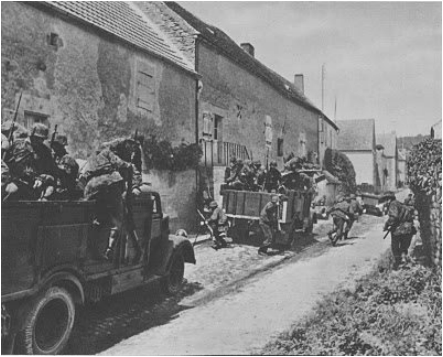
III. 24. Mai. 1940 – Beuvry / Hinges
- On 24. Mai, 1940, members of SS-TK-I.R.1, SS-TK-Pio.Btl. murdered 48 civilians in the village of Beuvry. The village of Beuvry is next to Bethune on the Le Blassee Canal, which was a critical crossing the men of the SS-Totenkopfdivision had to make. The fighting in and around Bethune and Beuvry was brutal, consisting of hand to hand combat and house to house street fighting.
The men of the SS-Totenkopfdivision took heavy casualties crossing the Le Blassee Canal, and actually had to make the crossing twice, due to being called back after successfully crossing it, during Hitler’s famous stopping order, that allowed the British and French to escape to Dunkirk.
The man in command of the troops fighting in Beuvry was SS-Sturmbannfuhrer Walter Bestmann, who had served prior in the SS-Totenkopfverbande, and was now serving as the commander of III./SS-TK-I.R.1., also attached to his unit was 1./SS-TK-Pio.Btl. commanded by SS-Obersturmfuhrer Siegfried Muller.
Although the crimes committed against the civilians did happen during combat in the town, it is stated that members of these two units executed the civilians and they were not just casualties of the combat happening in their villages. In total, 48 civilians were killed in Beuvry.
On the same day, in the village of Hinges, men of 3./SS-TK-Pio.Btl. under the command of SS-Obersturmfuhrer Max Seela executed 10 people, whether they were P.O.W.’s or civilians is unknown, however it was done in reprisal to an SS man being executed by a French soldier.
- On 24. Mai, 1940, members of SS-TK-I.R.1, SS-TK-Pio.Btl. murdered 48 civilians in the village of Beuvry. The village of Beuvry is next to Bethune on the Le Blassee Canal, which was a critical crossing the men of the SS-Totenkopfdivision had to make. The fighting in and around Bethune and Beuvry was brutal, consisting of hand to hand combat and house to house street fighting.
The men of the SS-Totenkopfdivision took heavy casualties crossing the Le Blassee Canal, and actually had to make the crossing twice, due to being called back after successfully crossing it, during Hitler’s famous stopping order, that allowed the British and French to escape to Dunkirk.
The man in command of the troops fighting in Beuvry was SS-Sturmbannfuhrer Walter Bestmann, who had served prior in the SS-Totenkopfverbande, and was now serving as the commander of III./SS-TK-I.R.1., also attached to his unit was 1./SS-TK-Pio.Btl. commanded by SS-Obersturmfuhrer Siegfried Muller.
Although the crimes committed against the civilians did happen during combat in the town, it is stated that members of these two units executed the civilians and they were not just casualties of the combat happening in their villages. In total, 48 civilians were killed in Beuvry.
On the same day, in the village of Hinges, men of 3./SS-TK-Pio.Btl. under the command of SS-Obersturmfuhrer Max Seela executed 10 people, whether they were P.O.W.’s or civilians is unknown, however it was done in reprisal to an SS man being executed by a French soldier.
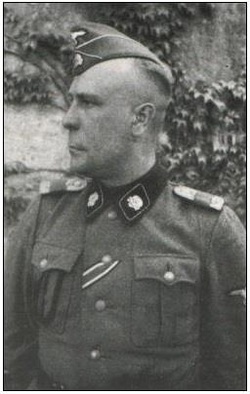
IV. 27. Mai. 1940 - Le Paradis
- On 27 Mai, 1940, members of I./SS-TK-I.R.2 murdered 97 British P.O.W.’s at a farm house near Le Paradis. After successfully crossing the Le Blassee Canal for the second time on 26. Mai, the SS-Totenkopfdivision continued their push and at dawn on 27. Mai, were engaged at Le Cornet Malo, suffering staggering losses; 4 German officers were dead, and 150 enlisted men were killed along with another nearly 500 wounded. Eventually, the British were pushed back and around noon, I./SS-TK-I.R.2 began its attack on Le Paradis.
The unit that would be blamed for the atrocity is 3./SS-TK-I.R.2, under the command of SS-Obersturmfuhrer Fritz Knochlein. Knochlein would later be found guilty of war crimes and sentenced to death in 1947, however his guilt is still in question. At any rate, his unit, as part of I./SS-TK-I.R.2 was directly involved in the combat at Le Paradis, as well as earlier at Le Cornet Malo. His men had already experienced a morning full of bloodshed, near defeat, and high casualties; assaulting well trained British troops in fortified, or dug-in positions.
The British they were fighting at Le Paradis were from the 2nd Royal Norfolk Regiment, and had barricaded themselves inside a farm house on Rue de Le Paradis. They were told by higher command that they would not be able to receive any support and to withdrawal, but instead they held fast at a farm that is now infamous today.
Initially, when the troops from I./SS-TK-I.R.2 arrived, the British had hung a white flag out of the loft of the barn. When an SS man approached to discuss their surrender he was shot, and his unit was ambushed. As with earlier that morning, they began sustaining high casualties. By 1700 Hours, the British had ran out of ammunition and finally wished to surrender, to the now furious, and heavily inflicted SS men.
99 Survivors were brought out of the barn and lined up. Machine guns from 4./SS-TK-I.R.2, under the command of SS-Haupstrumfuhrer Schroedel were set up and fired into the British prisoners. Following them being gunned-down, the survivors were bayoneted, and the men from I./SS-TK-I.R.2 moved out of the area.
Although it was Fritz Knochlein who was hung for giving the order for the execution, this might not be true. Fritz Knochlein was at the location when the crime happened, but there are many clues that lead to the actual culprit being Schroedel from 4. Kompanie. He was superior in rank to Knochlein, and Knochlein with his own machine-guns, would not have ordered machine-guns from Schroedel’s Kompanie when his would have served the same purpose. However, by 1945, Schroedel had been killed, and Knochlein had survived, making him a prime candidate to place the guilt upon. For more information on the guilt of Fritz Knochlein, please read my article titled: “Fritz Knochlein and the Le Paradis Massacre; War Criminal or Scapegoat?”
- On 27 Mai, 1940, members of I./SS-TK-I.R.2 murdered 97 British P.O.W.’s at a farm house near Le Paradis. After successfully crossing the Le Blassee Canal for the second time on 26. Mai, the SS-Totenkopfdivision continued their push and at dawn on 27. Mai, were engaged at Le Cornet Malo, suffering staggering losses; 4 German officers were dead, and 150 enlisted men were killed along with another nearly 500 wounded. Eventually, the British were pushed back and around noon, I./SS-TK-I.R.2 began its attack on Le Paradis.
The unit that would be blamed for the atrocity is 3./SS-TK-I.R.2, under the command of SS-Obersturmfuhrer Fritz Knochlein. Knochlein would later be found guilty of war crimes and sentenced to death in 1947, however his guilt is still in question. At any rate, his unit, as part of I./SS-TK-I.R.2 was directly involved in the combat at Le Paradis, as well as earlier at Le Cornet Malo. His men had already experienced a morning full of bloodshed, near defeat, and high casualties; assaulting well trained British troops in fortified, or dug-in positions.
The British they were fighting at Le Paradis were from the 2nd Royal Norfolk Regiment, and had barricaded themselves inside a farm house on Rue de Le Paradis. They were told by higher command that they would not be able to receive any support and to withdrawal, but instead they held fast at a farm that is now infamous today.
Initially, when the troops from I./SS-TK-I.R.2 arrived, the British had hung a white flag out of the loft of the barn. When an SS man approached to discuss their surrender he was shot, and his unit was ambushed. As with earlier that morning, they began sustaining high casualties. By 1700 Hours, the British had ran out of ammunition and finally wished to surrender, to the now furious, and heavily inflicted SS men.
99 Survivors were brought out of the barn and lined up. Machine guns from 4./SS-TK-I.R.2, under the command of SS-Haupstrumfuhrer Schroedel were set up and fired into the British prisoners. Following them being gunned-down, the survivors were bayoneted, and the men from I./SS-TK-I.R.2 moved out of the area.
Although it was Fritz Knochlein who was hung for giving the order for the execution, this might not be true. Fritz Knochlein was at the location when the crime happened, but there are many clues that lead to the actual culprit being Schroedel from 4. Kompanie. He was superior in rank to Knochlein, and Knochlein with his own machine-guns, would not have ordered machine-guns from Schroedel’s Kompanie when his would have served the same purpose. However, by 1945, Schroedel had been killed, and Knochlein had survived, making him a prime candidate to place the guilt upon. For more information on the guilt of Fritz Knochlein, please read my article titled: “Fritz Knochlein and the Le Paradis Massacre; War Criminal or Scapegoat?”
V. 19-20. Jun. 1940 - Lyon / Chasselay
- Over the 19th and 20th of Jun, 1940, members of the SS-Totenkopfdivision murdered approximately 50 French Senegalese P.O.W.’s in and around the city of Lyon, and in the village of Chasselay. On 18. Jun, 1940, the city of Lyon was surrendered over, and declared an open city. It was on the route of the “Grossdeutschland” Regiment, and the SS-Totenkopfdivision. On 19. Jun, 1940, the lead elements of “Grossdeutschland” approached the city of Lyon. Flying a white flag from the top of an armored car, an officer from “Grossdeutschland” was shot in the head by a sniper on his way into what was expected to be, an open city. As it would turn out, although the city was formally surrendered, a commander from the 25th Regiment of Senegalese Tirailleurs decided to ignore the order, and had ordered two battalions to defend the city and the nearby village of Chasselay.
Soldiers from the SS-Totenkopfdivision and the Heer Regiment “Grossdeutschland” were then involved in heavy fighting trying to capture the city of Lyon, even though France had formally surrendered. The initial crimes committed occurred when a Senegalese machine-gun team and two officers were captured by men from “Grossdeutschland”, the black crews of the machine-guns, and both white French officers were executed. Nuns from the convent of Montluzin, in the area, also claimed watching men from the SS-Totenkopfdivision murder several Senegalese soldiers inside the convent, after having been wounded.
Eye witnesses stated that once the city of Lyon and the village of Chasselay were in German hands, prisoners were lined up in the street and separated from black and white. The whites were made to lie down in a field and watch the black troops get machine-gunned down. Following their execution, tanks from the Heer 10. Panzer Division were said to have rolled over the dead bodies to make sure none were still alive. Speratic fighting and subsequent killing happened in the area from the 19th to the 20th of June. In his report, SS-Hauptsturmfuhrer Adolf Kurtz, the Chef of 1./SS-TK-I.R.1, stated, “44 negroes killed, 10 white officers taken prisoner.”
Although the number of dead Senegalese and French troops number near 200 from the fighting, it is estimated around 50 of those were murdered by members of SS-Totenkopf after surrendering. The soldiers were frustrated from having been ambushed from an open city, as well as taking substantial casualties after the official surrender of France. Soldiers from both units had also been pre-conditioned towards racism prior to the campaign, which is evident in that many white prisoners were taken, but few black Senegalese troops were taken prisoner.
However, although the men of SS-Totenkopf killed a large number of black Senegalese troops, they also had taken thousands of black French Colonial troops prisoner during the prior and following weeks, evidence of the large number of these prisoners taken can be found in the SS-Kriegsberichter photos taken of the SS-Totenkopfdivision during it’s time in France.
- Over the 19th and 20th of Jun, 1940, members of the SS-Totenkopfdivision murdered approximately 50 French Senegalese P.O.W.’s in and around the city of Lyon, and in the village of Chasselay. On 18. Jun, 1940, the city of Lyon was surrendered over, and declared an open city. It was on the route of the “Grossdeutschland” Regiment, and the SS-Totenkopfdivision. On 19. Jun, 1940, the lead elements of “Grossdeutschland” approached the city of Lyon. Flying a white flag from the top of an armored car, an officer from “Grossdeutschland” was shot in the head by a sniper on his way into what was expected to be, an open city. As it would turn out, although the city was formally surrendered, a commander from the 25th Regiment of Senegalese Tirailleurs decided to ignore the order, and had ordered two battalions to defend the city and the nearby village of Chasselay.
Soldiers from the SS-Totenkopfdivision and the Heer Regiment “Grossdeutschland” were then involved in heavy fighting trying to capture the city of Lyon, even though France had formally surrendered. The initial crimes committed occurred when a Senegalese machine-gun team and two officers were captured by men from “Grossdeutschland”, the black crews of the machine-guns, and both white French officers were executed. Nuns from the convent of Montluzin, in the area, also claimed watching men from the SS-Totenkopfdivision murder several Senegalese soldiers inside the convent, after having been wounded.
Eye witnesses stated that once the city of Lyon and the village of Chasselay were in German hands, prisoners were lined up in the street and separated from black and white. The whites were made to lie down in a field and watch the black troops get machine-gunned down. Following their execution, tanks from the Heer 10. Panzer Division were said to have rolled over the dead bodies to make sure none were still alive. Speratic fighting and subsequent killing happened in the area from the 19th to the 20th of June. In his report, SS-Hauptsturmfuhrer Adolf Kurtz, the Chef of 1./SS-TK-I.R.1, stated, “44 negroes killed, 10 white officers taken prisoner.”
Although the number of dead Senegalese and French troops number near 200 from the fighting, it is estimated around 50 of those were murdered by members of SS-Totenkopf after surrendering. The soldiers were frustrated from having been ambushed from an open city, as well as taking substantial casualties after the official surrender of France. Soldiers from both units had also been pre-conditioned towards racism prior to the campaign, which is evident in that many white prisoners were taken, but few black Senegalese troops were taken prisoner.
However, although the men of SS-Totenkopf killed a large number of black Senegalese troops, they also had taken thousands of black French Colonial troops prisoner during the prior and following weeks, evidence of the large number of these prisoners taken can be found in the SS-Kriegsberichter photos taken of the SS-Totenkopfdivision during it’s time in France.
